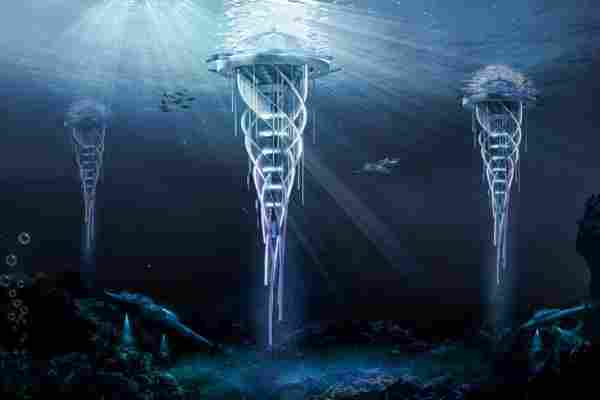
The idea of completely rejecting fossil fuels isn’t new, although there are multiple alternatives to take. Electricity, solar energy, hydrogen combustion, all prove to be incredible substitutes for ‘dirty’ fossil fuels, although some believe there’s another abundantly available alternative – combustible ice.
Combustible ice is found in large quantities at the bottom of our oceans. These ice-shaped masses are made when water and natural gas get frozen together. Also known as methane hydrate or flammable ice, this white snow-like mass burns to release water and methane as by-products, and some believe its abundance could help offset our current carbon crisis by shifting us to the next best thing.
The Drilling Water-Scraper is a conceptual architectural design that recieved an Honorable Mention at the 2020 eVolo Skyscraper Competition . The water-scrapers extend downwards to the ocean bed, mining it for combustible ice, while the upper half gathers plastic waste from the ocean, effectively cleaning it. There are two main moving lines in the building, the downward materials, and the upward energy. Among them, the energy tower transforms the plastic waste on the sea into 3D printing materials, and prints the building and energy tank down along the core cylinder, turning itself into a building with growth. Mined ice is pressurized and liquefied before being stored in the water-scraper’s energy tanks. Cargo ships make their way to the scrapers and collect this energy, bringing it to the cities.
Designers: Xuejun Bai, Chucheng Pang, Lei Zhai, Yuyang Sun & Dianao Liu
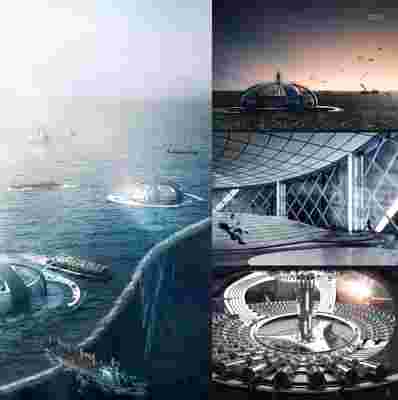
Tiny Homes On Wheels that are the trending micro-living setups you will love!
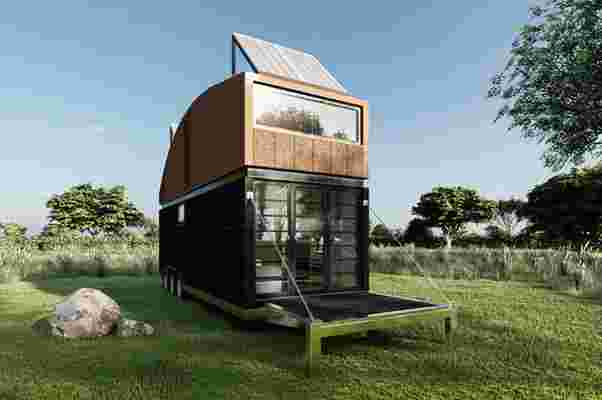
Sustainability has been running on everybody’s mind. Ever since the pandemic shook up our world, we’re trying to incorporate sustainability into every aspect of our life, including our homes! With everyone aspiring toward’s eco-friendly and mindful ways of living, tiny homes have been taking over the architecture world and they continue to grow popular by the day. And, tiny homes on wheels, in particular, have really taken us by storm! What started off as a cute little trend is now turning into a serious option for home spaces that are portable and travel-friendly. You can now take your cozy and comfy home with you, wherever you travel! These tiny homes on the move are simple and minimal alternatives to the imposing and materialistic homes that seem to have taken over. And, we’ve curated a wide range of travel-friendly micro-home setups that will cater to everybody’s unique needs and preferences! There’s a tiny home out there for everyone.
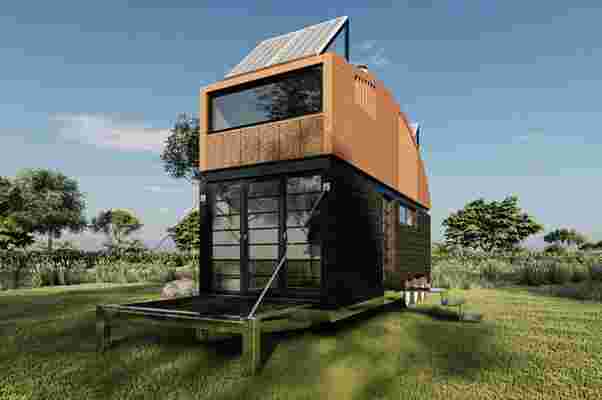
Natura is a wonderful example of the best to come out of the tiny house movement, it is an environmentally friendly home on wheels! “As negative as pandemic has been throughout the world, a positive thing that’s come from it is people have really come to realize that nature is important to people’s lives,” says Smith-Burchnell, Founder and Director of The Tiny Housing Co. One of my favorite things about tiny homes is the loft-style beds because they give you a little private cozy corner and that is exactly how the bedroom in Natura is set up. It has a multifunctional king-sized bed with plenty of storage under the frame.
Modern-Shed, a leader in innovative, sustainable, prefabricated structures, heard our 11:11 wishes and designed Dwelling on Wheels, or DW for short. Their Dwelling on Wheels is a 220-square-feet tiny home on wheels that buyers can bring with them on the road and situate on coastlines or nearby riverbeds for overnight stays and views. Built to withstand varying climates and temperatures, a steel rib cage and standing seam metal siding wraps around the exterior of DW for a durable and weather-tight finish. Complementing the industrial cottage design, red cedar wood accents warm up the walls, eaves, and even the tiny home’s awning that hangs overhead a durable, ironwood deck, accessible through the dwelling’s double-pane glazed gable door.
Built to be net-zero through several sustainable features and compact enough to meet all NZTA regulations for mobile homes, Ohariu was built by First Light Studio and Build Tiny from a client’s brief calling for, “a refined tramping lodge on wheels.” That’s code for hiking, for all us Americans. Since the tiny home would primarily be used for hiking trips and traveling throughout the outdoors, Ohariu was built to be adaptable and versatile above all else. Inside, the living spaces are described by the architects at First Light Studio as being, “more a large and very detailed piece of furniture than a traditional house build, the fit-out [focusing] on the things that are important and necessary.”
Just like the rest of us, Matt and Lisa of Tailored Tiny Co. have been dreaming about tiny homes for quite some time and Living Big in a Tiny House caught up with them soon after they constructed one of their own. Nestled high above an Australian forest, Matt and Lisa’s jet-black, two-floor tiny home was constructed by the couple with help from a few friends. The tiny home’s black metal siding surely stands out, but amidst high eucalyptus treetops, it offers a more inconspicuous appeal, tying it up artfully with recycled hardwood trimming for the home’s protruding gables. Matt and Lisa’s home-on-wheels measures almost 30 feet in length and just about eight feet in width – the ceiling reaches sweeping heights of 14 feet, slightly above average for the conventional tiny home.
The Tiny House Baluchon created this adorable wooden tiny home on wheels for a family of two! Named Kiwi, the cheerful green accents in the home are probably the reason for its name. The double-decker is fully furnished, with a little kitchen space, dining table, bedroom, and loads of windows, creating an open and wholesome space, that would also be super fun to travel in!
Coming in at 8 x 2.7 m, with a steel frame and aluminum exterior, the Cyril House is a double-decker one-bedroom with a full-size kitchen, lounge area, bathroom, and home office. Resting on a double-axle trailer, this tiny home comes with a high ceiling that opens up the tiny home even further for you and your feline friend. Mounted between the office and the loft bedroom, carpeted shelves stagger between one another for your cat to traverse while you study or get work done in the home office upstairs.
Ecuador-based Jag Studio designed La Casa Nueva – a timber camper that is also a fully functional tiny home so you can set up your base anywhere. It includes a bed, a roof, workstations, a kitchen, and a bathroom making it a comfortable shelter for two people. The design team was lead by Juan Alberto Andrade and Cuqui Rodríguez who actually built La Casa Nueva for themselves so they could be on the road and continue photographing architecture across Ecuador. Its compact size, ability to be configured and mobility allows you to stay in different locations for short periods of time.
Bivvi is a modular and transportable A-frame cabin that can either be attached to your car for road trips or to a chosen foundation for permanent placement. The creators at Bivvi make up a team of travelers and adventure-seekers– they built Bivvi so that we can be too. They set out to build Bivvi after noticing the inherently immobile and expensive nature of cabins and other modes of residence for travelers already on the market. Taking on mobility as their main source of inspiration, each Bivvi Cabin can be attached to a trailer hitch and tow so that they can be transported anywhere.
Another creation by The Tiny House Baluchon , this tiny home is a bright and functional place to live in! The owner is a lover of the ocean, which has been reflected in the home. Navy blue furniture, an impressive anchor above the front door, little seagull attachments on the wall are a few of the ocean-inspired additions to the home.
Following a brief to design an inspiring, new luxe edition of the traditional holiday home and put it on wheels, Adria concocted Astella . With luxury in mind, less is more with Astella. In a similar fashion to the famed luxury of Pan Am cockpits, Astella features an open floor layout that hinges on a simple design to highlight sophisticated elegance. Inside, the mobile home is as expansive as it is clean and subdued. Adria aimed to create Astella with clean, focused lines throughout its interior to enhance the mobile home’s high ceiling and spread-out floor plan. Featuring a living area, kitchen, bathroom, and bedroom, Astella manages to pack a lot of luxury in a small space thanks to its simplicity of design. Built to be ergonomic and intuitive, the simple layout of Astella was inspired by hotel luxury experiences that highlight the home’s functionality and simplicity.
Heavenly Abode
Rebuilding New Orleans is an ongoing effort and pitching into the concept-zone is the New Orleans Arcology Habitat or NOAH. Since the details on this structure are in-depth and plenty, lets plunge into them right away. NOAH proposes to be a habitat for 40,000 residents who can benefit from the planned residential units, school system, commercial, retail, hotels, casinos, parking, and public works facilities. NOAH is based upon the following preliminary program outline.
1. Residential Units / Rental and Condominium; 20,000 units @ average 1100 Sq ft 2. Three Hotels; Average 200 rooms plus associated services 3. Time Share Units; 1500 units @ average 1100 sq ft 4. Three Casino Facilities 5. Commercial Space / Rental and Condominiums; 500,000 sq ft 6. Commercial Space / Retail; 500,000 sq ft 7. Parking Garage / within foundation; 8,000 cars 8. Cultural Facilities; 100,000 sq ft 9. Public Works; 50,000 sq ft / includes storage 10. District School System; 100,000 sq ft 11. District Administrative Office; 50,000 sq ft 12. District Health Care Facility; 20,000 sq ft
Estimated Total Square Footage : 30 million
Location/ Site Specific:
In reviewing all the options and possible sites for NOAH, the most logical location is on the Mississippi riverfront and adjacent to the Central Business District.
Design Challenge:
1. The first challenge is to overcome both the physical and psychological damages of recurring severe weather patterns. Though re-population has begun, the need to provide a stabilized and safe environment is paramount to a long term recovery and economic well being of New Orleans. 2. The second challenge is that New Orleans has too much water. The city has been built at and below sea levels which creates consistently high water table and makes it prone to flooding and storm surges. 3. The third challenge is that New Orleans is built on soil condition which consists of thousands of feet of soft soil, silt and clay. These conditions make building large scale concentrated structures difficult. Believing that NOAH is a viable plan, our solution to overcome these challenges is to take advantage of these seemingly conflicting issues with the introduction of a floating urban platform.
Foundation Design / Basin
The NOAH foundation system is twofold. The first part of the system is to create a water filled “basin” within which the urban platform (NOAH) will float.
The second part of the system is to create a multi-cavity “hull” which will be the actual foundation for the superstructure.
Basin/Foundation :
The water basin will be a combination of carving into the existing land and extending out into the Mississippi River. This man made basin is estimated to be 1,200 feet in diameter with a depth of 250 feet. The walls and floor of the basin would be constructed of high strength concrete with applied lateral bracing and exterior attached tension rings. Backup intact valves will allow basin and river water levels to remain constant.
The Foundation:
Noah, at its current height of 1,200 feet will rest up its triangulated foundation constituted to be a buoyant multi-cavity “hull.” This “hull” will consist of high strength concrete cells, forming approximately a 40×40 matrix. This matrix not only gives buoyancy to the structure, it also becomes the framing matrix for the steel framed superstructure. It is estimated that the combined weight of NOAH will draft 180 feet within the water-filled basin, allowing a minimum 50 foot space between the floor of the basin and the floor of the buoyant foundation.
The hull will accept all land connectors as flexible conveyors to take into account any movement. A triangulate shape has been chosen as the basis for NOAH. For two reasons:
First , the triangle is inherently the most rigid of all structural framing systems. The system is designed to dissipate gravity and severe wind loads through an all-steel applied (eko skeleton) exterior frame and conventional internal framing methodology.
Second , the triangle is an “open” frame configuration, dividing NOAH into three separate “towers” converging at the top. The intent of this open system is to allow all severe weather /winds to in effect “blow through” the structure in any direction with the minimum of massing interference.
Some Other Features:
1. Sky Gardens will be inserted into the three main towers every 30 floors. These sky gardens provide landscaped glass enclosed atria. 2. Vertical commuting within NOAH will be supported by a series of local and express custom canted elevators. 3. NOAH is geared to an all pedestrian environment. Accordingly, only select horizontally based areas will be fitted with moving walkways and/or electric train carriers. NOAH is a three phase master plan with a proposed 10 year build out. This time frame can be reduced to an estimated 6 years should demand accelerate.
Eco-Highlights: The structure is designed to expand the horizon of sustainability and will seek LEED certification. It will eliminate the need for cars within the urban structure, and thus becomes a carbon neutral entity. Internal electric transport links, vertical and horizontal, create a pedestrian-friendly community, Some of these elements are secured wind turbines, fresh water recovery and storage systems, passive glazing system, sky garden heating/cooling vents, grey water treatment, solar array banding panels, and river based water turbines.
[youtube:http://www.youtubeom/watch?v=w1Flnbn53dY 468 344]
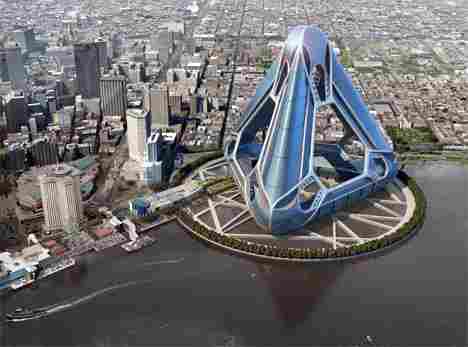
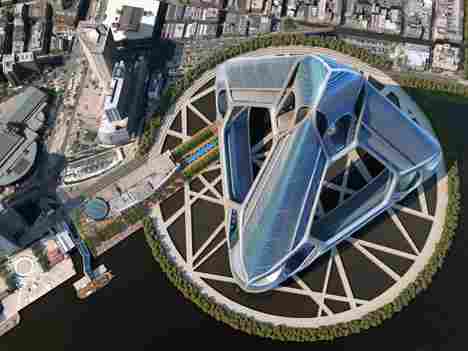
NOAH Team
Design / Concept: E. Kevin Schopfer AIA, RIBA
Executive Architect: Ahearn / Schopfer Associates; Boston, MA Cambridge Seven Associates, Inc.; Cambridge, MA
Associate Architect: Raymond C. Bergeron, NCARB; New Orleans, LA
Visual: Tangram 3DS ; Kittery, ME
Structural / Mechanical: Arup; Boston, London
Foundation Consultants: Acergy; New Orleans, LA








